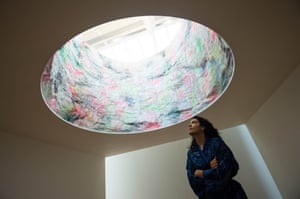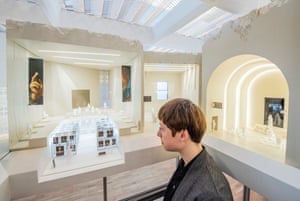From the GuardianI've seen the future and it's porn, pollution and penthouses – review of Is This Tomorrow?
Oliver Wainwright
‘Is This Tomorrow?” asks a new exhibition at the Whitechapel Gallery. One rather hopes not, if this car crash of forced collaboration, muddled thinking and hasty installation art is anything to go by.
The show takes as its premise the idea that a hugely influential, agenda-setting exhibition staged 63 years ago might be re-created for the present day with just as much impact. The original spectacle, titled This Is Tomorrow, opened at the Whitechapel in 1956, then a gritty outpost in London’s wild East End.
It was a landmark event, helping to launch the careers of its thirtysomething participants, from pop artists Richard Hamilton and Eduardo Paolozzi, to architects Alison and Peter Smithson and James Stirling. It has since been the subject of endless PhDs, reconstructions and revisions, taking on an aura as a seminal moment in the development of the modern British psyche. So the stage was set for the inevitable finale: the re-enactment.
The chief difference between the original and the homage is that many of the former’s participants already knew each other and had something interesting to say. In other words, there was a reason for the exhibition to happen. By contrast, the motivations for the current show betray a pining nostalgia for the past and loss of confidence in the present.
S:ome of this is intentional. The flipping of the title implies that all is not well: this is a show of speculation and trepidation, not emphatic proclamations about what’s coming next. While the postwar mood was one of optimism, with the end of rationing, the launch of wholesale reconstruction projects and the foundation of a free health service, the present outlook is significantly more bleak. In a world of Trump, Brexit, right-wing populism and environmental armageddon, we have more worries than ever. One of them is how to make a meaningful group show out of artists’ and architects’ competing ambitions.
Curator Lydia Yee began by asking a handful of participants who they would be interested in working with, the result being a kind of creative blind date where few of the participants knew each other. Her choices were good, and considerably broader than the 1956 show, cutting a cross-section through some of the most interesting architects and artists working today around the world, hailing from Argentina, Bangladesh, Canada, China, France, Germany, Iran, Mexico, Spain, Tanzania and the US. There are also considerably more women than the mostly white male line-up in the original show.
Each pairing was given a budget of £10,000 and a dangerously open brief to make something vaguely relating to the future. The result is the ragbag you might expect, with some provocative things in the mix, but a general sense of incoherence.
Amalia Pica and 6a architects have built a holding pen for visitors made of sheep fencing, herding gallery-goers into a little obstacle course that sees them crawling through gates, on to a weighing scale and into a fold populated with farmyard toys. It feels like a wry comment on the modern gallery experience, as well as being a useful place to leave the kids while you see the rest of the show.
Their agricultural maze zigzags around a faceted star-shaped pavilion by David Adjaye and Kapwani Kiwanga, whose walls of dichroic glass form a pastel rainbow of reflections as you pass around and through it. It is a pleasing and elegantly made thing, but would perhaps feel more at home at a furniture fair.
A dose of subversive mischief comes from Andrés Jaque and Jacolby Satterwhite, who have built a big black mountain of gloopy foam and plastic flowers, in which a series of monitors play a stream of consciousness collage on the unlikely intersection of high-end real estate, Grindr, pornography and pollution displacement in New York. It’s a heady cocktail, but worth watching the whole video for a sideways look at some of the stranger invisible forces shaping Manhattan’s skyline.
Upstairs, you find a scaffolding frame from which some oversized Meccano components dangle, the result of a collaboration via Skype between Mariana Castillo Deball and Tatiana Bilbao. Something appears to have been lost in translation, or maybe the wifi broke. The promising pairing of Rana Begumand Marina Tabassum next door is also disappointing, consisting of a banal white box with a circular roof light cut out, clad with spray-painted crumpled metal. Like many of the other pairings, the whole is less than the sum of its parts. It often feels as if each party thought the other one was in charge – the result being that the responsibility fell between two stools.
Just as you might be about to give up, a piece comes along that makes the exhibition worth visiting. Simon Fujiwara (an artist who first trained as an architect) and David Kohn (an architect who frequently collaborates with artists) have concocted an exquisitely crafted model of their imaginary museum for the most hyped artwork in history: The Salvator Mundi Experience.
Duck your head inside their doll’s-house world to be treated to a dedicated attraction where the story of the long-lost “male Mona Lisa” is re-enacted step by step, from the Room of Rediscovery, recreating the staircase scene where the painting by Leonardo da Vinci was spotted, to a restoration studio mock-up, to the Christie’s Experience. There is also a suite of galleries dedicated to how the artwork – which was auctioned for $450m in 2017 – might be displayed and interpreted for the social media generation, including a wall-size screen that responds to visitors’ facial expressions, reducing the holy visage to an interactive Instagram filter.
It beautifully skewers the commodification of the painting, the role of the mega-museum, and the strange future of the multimedia visitor experience – depicting a world that very much is tomorrow, whether we like it or not.


Comments
Post a Comment